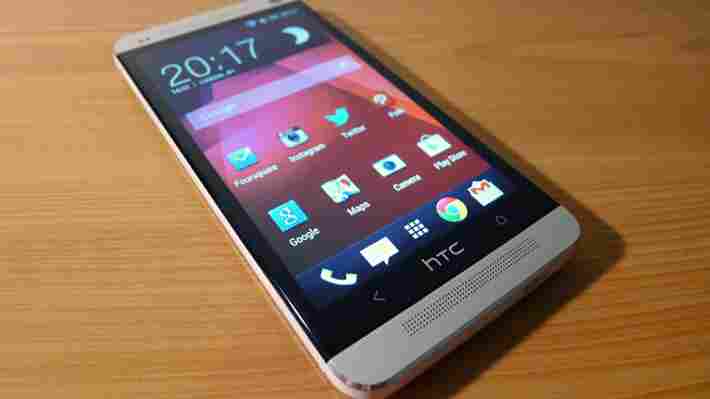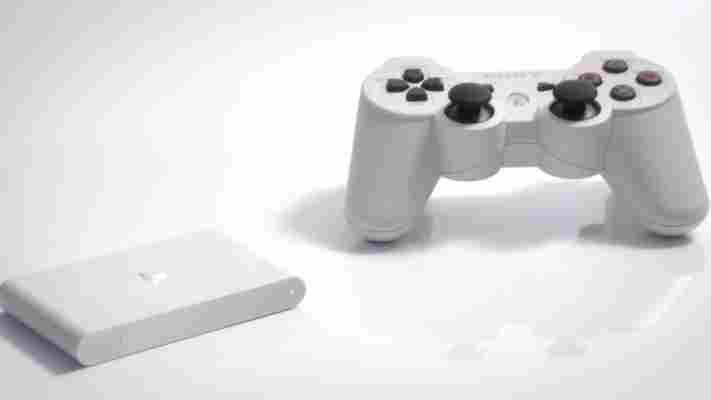A dual-SIM version of the HTC One, the Taiwanese smartphone maker’s flagship Android handset, was unveiled today and is now available to pre-order for £494.99 ($809 USD) in the UK.

The updated HTC One also offers a microSD card slot for up to 64GB of additional space. Both of these options will be available via a removable back cover, giving users the ability to swap out their cards with minimal fuss.
HTC says it’s targeting the device at foreign nationals, students and business customers who regularly travel abroad. That certainly makes sense with the dual-SIM support, but we expect that the new microSD card slot will make the handset appeal to an even wider pool of Android power users.
Elsewhere, the dual-SIM version of the HTC One is almost identical to the original version that launched earlier this year. It sports the same attractive aluminium body, the terrific dual front-facing speakers and Sense 5 with HTC BlinkFeed, its customizable stream of news and social media updates.
Unfortunately, the device doesn’t support LTE and will be launching with Android Jelly Bean out of the box. Version 4.4 (KitKat) would have been ideal, but hopefully it’ll arrive as an update in the coming months.
The device is available to pre-order now in the UK. We’ve reached out to HTC to confirm whether there are plans to release the device in other markets.
➤ HTC One Dual-SIM (via PocketLint / Android Central )
Sony’s $100 PS Vita TV isn’t perfect, but it has the potential to surpass Apple TV, Roku and OUYA
No-one was expecting PS Vita TV . There were no leaks. No rumors. The spotlight was firmly focused on the PlayStation 4 and Xbox One , so the chances of Sony announcing a new piece of hardware were slim.

Yet they did. PS Vita TV might not be a perfect product, but I don’t mind. Even in its current state, I think it looks fantastic.
The system is understated and tiny. Based on the images and promotional videos released so far, it looks smaller than a regular point-and-shoot camera. It makes the Android-powered OUYA look excessive. Bulky even, which is quite an achievement given that the Kickstarter-funded gaming console is roughly the size of a Rubik’s Cube.
When Sony launches PS Vita TV in Japan this November (a wider release is yet to be confirmed) it’ll be sold for just 9,954 yen. That’s sub-$100 , which is exactly the same as OUYA, Apple TV and other set-top streaming boxes such as Roku . For new hardware, it’s a highly competitive price point.
The microconsole plays a mixture of both new and classic games. Players will eventually have access to 1,300 titles originally released for the PlayStation and PS One, as well as the more recent PlayStation Portable and PS Vita systems. It’s not a complete library for any of these consoles, but it’s a notable sum of what used to be a full, $60 experience.
The system can play Vita cartridges too, although the list of supported games is restricted. PlayStation Vita TV uses the Dual Shock 3 controller, so any titles that use the PS Vita’s front and back touchscreen aren’t supported. That rules out some of the original PS Vita’s best games including Uncharted: Golden Abyss , Wipeout 2048 and Gravity Rush .
It’s a huge flaw.
Nevertheless, PS Vita TV should have a great library of games targeted at traditional console players in Japan. It’s a true handheld gaming console, but ported to the television for a fraction of the price. Unlike OUYA, it also comes with a comfortable and durable controller that players already love.
The cost of each title is yet to be confirmed, but they’re likely to mirror the current prices for PS Vita digital content. That could be a shock to the average person who is used to spending 99 cents on an iOS or Android app, but it’s important for Sony to emphasize that these are big budget games, without any unscrupulous free-to-play mechanics or microtransactions hidden inside.
Of course, Sony also has the option to offer additional games on PS Vita TV at lower price points. The infrastructure and marketplace already exists, they just need to make it happen.
Regardless, the current pricing model should be a compelling offer for parents. As with traditional gaming consoles (provided they don’t save their debit or credit card details) they can buy a game once and not have to worry about their child or children spending an eye-watering amount of money by mistake.
PS Vita TV can be used to access video and music services such as Hulu , Music Unlimited , Video Unlimited and Nico Nico . It’s essentially the PS Vita hardware and UI, but with a couple of new apps thrown into the mix.
The system supports Remote Play, which means that players can stream PlayStation 4 games and potentially other multimedia content to whatever display the PS Vita TV is hooked up to. So unlike OUYA, Apple TV, Roku and other set-top streaming boxes, the console is capable of true next-gen gaming. Admittedly, this functionality relies on consumers being invested in the Sony ecosystem, but it’s a unique feature for the system.
On its own, PS Vita TV’s streaming capabilities are a little limited. That could change, however, if Sony ever decides to release it on Western shores. If the company can bring on board services such as Netflix , Amazon Instant Video (or LoveFilm Instant , depending on your region), ESPN and HBO GO , PS Vita TV will be a day one purchase for many people, myself included.
A traditional console experience, coupled with some of the best streaming services for less than $100. It’s an easy sell.
For now, it makes sense for Sony to release the PS Vita TV as an exclusive for Japan. The PlayStation 4 is launching in North America on November 15 , before hitting Japan on February 22 next year.
Why the gap in release dates? Sony wants to prioritize Western markets with the PlayStation 4. These areas are akin to swing states in a presidential election campaign: Sony has always been strong in Japan, so it wants to focus its efforts on these pivotal countries where opinion is still divided.
That decision has already upset some of its fans in Japan though. PS Vita TV could arguably be seen as a peace-offering by Sony, a final safeguard to reassure its domestic supporters over the New Year period.
But there’s another angle here. The PS Vita TV is an unknown quantity for Sony. At this point, it’s difficult to see OUYA and other microconsoles such as the GameStick , Gamepop and NVIDIA Shield ever truly taking off. But if they do, Sony has a platform it can quickly push out internationally.
The system is a line in the sand. An indication by Sony that it can compete with inexpensive, low-end hardware if needed.
It’s difficult to predict what Apple will do next with its own set-top streaming box. Apple TV has never been a huge product for the company, at least not in comparison to the iPhone, iPad, iMac and MacBook.
Many believe that Apple wants to give the platform a major revamp, provided it can get the necessary deals in place with broadcasters and content providers.
It could also enter the gaming market in a huge way. Apple already has a massive catalog of iOS games in the App Store, many of which users have already purchased. If it were to give players the ability to simply download their library at no extra cost and play them freely on their television, Apple TV would be huge.
If that were to happen, the average family could shy away from the $399-$499 price point of the Xbox One and PlayStation 4. Gamers will always want the big budget, traditional console experience, but it’s easy to see the casual, Nintendo Wii and Kinect market transitioning to Apple TV. Especially with AirPlay and the existing iTunes storefront thrown into the mix.
Whether or not a next generation Apple TV emerges, Sony is well-positioned to push back with the PS Vita TV. It’s pretty cheap – perfect for new players – and an ideal counterpoint to the expensive, bleeding edge technology found in the PlayStation 4.
But the system is flawed. The inability to play titles that make the most of the original PS Vita’s innovative hardware will be a huge letdown to many players. An easy, inexpensive workaround is vital if the PS Vita TV is to ever become a commercial success.
Likewise, it needs widespread app support. Pulling from the $399 PlayStation 4 isn’t enough, and in many ways derails the original purpose of the system. If Sony is to release the device globally, it’ll need to offer an identical library of apps to Roku and Apple TV, if not more.
Despite these shortcomings, the PS Vita TV has huge potential. The hardware is sleek, the games are compelling and it’s priced competitively. If Sony supports it properly, I see no reason why it can’t coexist with the PlayStation 4 and eventually surpass other microconsoles and set-top streaming boxes.
Lunecase hits Kickstarter to bring simple notifications to the back of your iPhone without draining your battery
When using phones, we mostly pay attention to the front side of the gadget where the screen is, while its rear isn’t usually considered to be of any importance. Ukraine-based startup Concepter, known for its crowdfunded smartphone flash iblazr , has decided to put the back of your iPhone to use by giving it simple notifications for calls and text messages.

Surprisingly, the $50 “smart case” dubbed Lunecase, a Kickstarter campaign of which began today, does not have a battery of its own.
Moreover, it lacks any connectors as it only needs to catch electromagnetic waves that iPhone emits when receiving a call or a text to both power it and determine what exactly is happening. As a consequence, call or a text notifications appears a second before the phone starts ringing and disappears after a call has finished, or three seconds after a text is received.
The 0.125-inch thick protective case available in black and white will cost Kickstarter backers anywhere from $29 to $39, while its retail price will be $50. Providing the goal of $50,000 is achieved, first shipments of Lunecase will begin in August.
Concepter CEO Vladislav Tislenko says that developing a technology to determine the nature of electromagnetic waves — i understanding which notification to show the user — was the hardest part. The startup plans to widen the range of cases later on, while no plans of catering Android users are in evidence.
It’s worth noting that Concepter team are no strangers to campaigning on Kickstarter. The startup’s previous product, smartphone flash iblazr featured on TNW back in July, was a huge success with more than $150,000 raised of the initial goal of $58,000.
Currently, together with launching the Lunecase campaign, the team of a dozen people is busy with pushing its first gadget to the US market. As Tislenko said in an interview with TNW, the company has already shipped a few thousand flashes and signed a contract with US retailer NewEgg. Negotiations are also underway with a few other US and Asian major distributors.
In addition to that, Concepter is already working on iblazr 2.0, the next generation of its smart flash and “a secret weapon full of innovations” due to be released in the end of 2014. Tislenko is apparently very proud of this but he won’t give the media any details.
In a nutshell, Concepter is an interesting startup to follow that is being built as a “Kickstarter company,” using crowdfunding not only for its first (or only) product as many do, but making the platform a basis for its whole business model.
➤ Lunecase [Kickstarter]
